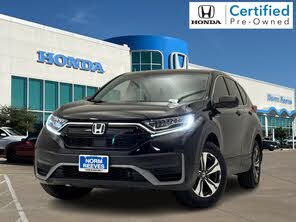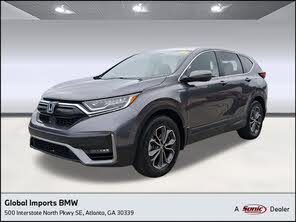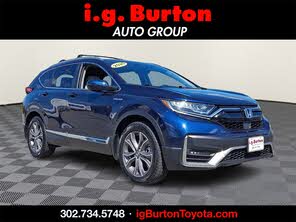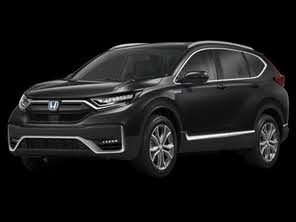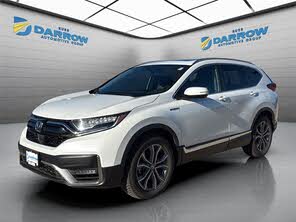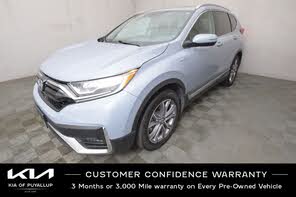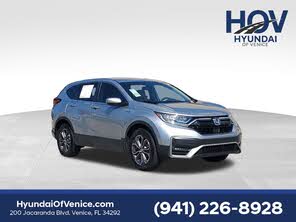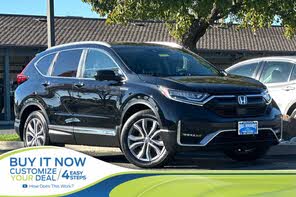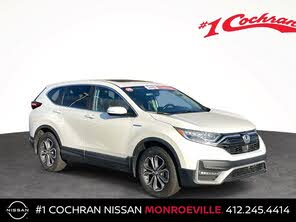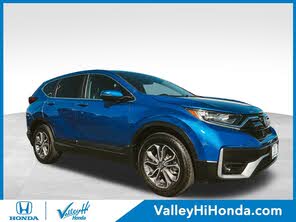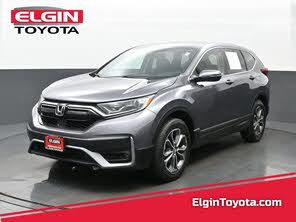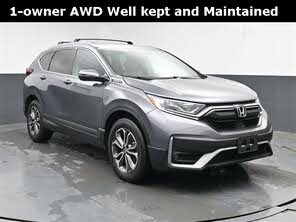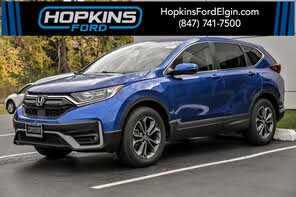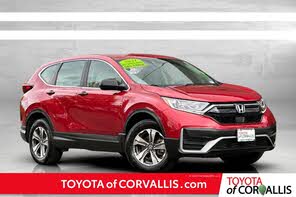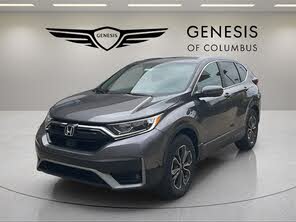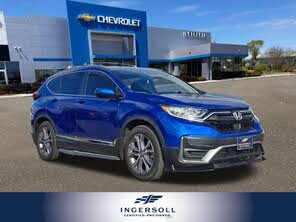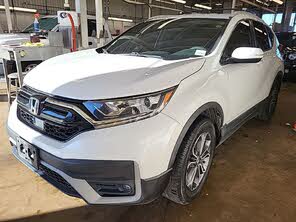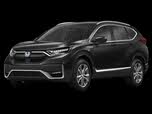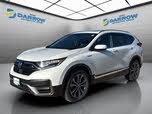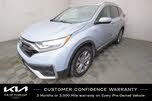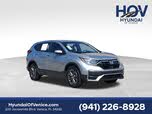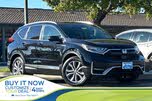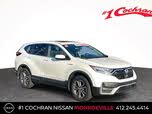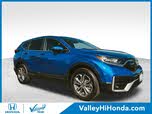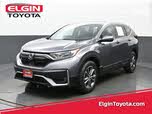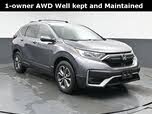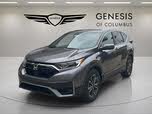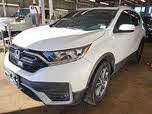2020 Honda CR-V Hybrid vs 2021 Honda CR-V
Overview | |
MSRP$27,850 | MSRP$25,350 |
Listings217 | Listings1279 |
Ratings & Reviews | |
User Reviews | User Reviews |
Expert reviews7.3 out of 10 | Expert reviews7.8 out of 10 |
Pros
Cons
| Pros
Cons
|
2020 Honda CR-V Hybrid Reviews SummaryOne of the forerunners to today’s seemingly never-ending onslaught of crossover SUV debuts, the Honda CR-V entered the market when SUV meant body-on-frame truck and CUV meant, well, nothing. The year was 1996 and the only other crossover option in the U.S. was the Toyota RAV4, which went on sale the year prior. Since then, hybrid technology has become commonplace. Yet, Americans have lived without a battery-assisted Honda crossover. That finally changes, with the debut of the 2020 Honda CR-V Hybrid. | |
2021 Honda CR-V Reviews SummaryEven in a grim year, Honda is selling a staggering number of CR-Vs. The CR-V is the best-selling Honda by far. It’s also the second best-selling compact SUV, just behind the Toyota RAV4. And it's the fifth best-selling vehicle in the U.S., and if you take out all the commercial sales of full-size pickups it’s one of the two best-selling vehicles year in and year out. So it’s hard to argue against the CR-V formula. Honda’s been at this almost as long as crossovers have been a thing, launching the CR-V in 1997—a year after the RAV4 debuted. The funny thing is, aside from sales volume, there’s only one thing the CR-V particularly excels at. Aesthetics are subjective, but it would be hard to argue the CR-V is the best looking vehicle in its class. It’s not the cheapest. It’s not the best equipped, especially at the middle to lower trim levels. It’s not the fastest, nor is it the quietest, or the most fuel efficient. It’s not even the most reliable, showing up nowhere in J.D. Power's Most Reliable list. So what makes it so appealing to American consumers? Let’s see if we can figure that out. | |
No video found | No video found |
Popular Features & Specs | |
Engine2.0L 212 hp I4 Hybrid | Engine1.5L 190 hp I4 |
Drive TrainAWD | Drive TrainFWD |
Seating Capacity5 | Seating Capacity5 |
Horsepower212 hp @ 6200 rpm | Horsepower190 hp @ 5600 rpm |
EV Battery Capacity1.3 kWh | EV Battery Capacity |
MPG City40 | MPG City28 |
MPG Highway35 | MPG Highway34 |
Engine | |
Engine Name2.0L 212 hp I4 Hybrid | Engine Name1.5L 190 hp I4 |
Torque | Torque179 lb-ft @ 2000 rpm |
Horsepower212 hp @ 6200 rpm | Horsepower190 hp @ 5600 rpm |
DrivetrainAWD | DrivetrainFWD |
Fuel Economy | |
EV Battery Capacity1.3 kWh | EV Battery Capacity |
MPG City40 | MPG City28 |
MPG Highway35 | MPG Highway34 |
Interior | |
Seating Capacity5 | Seating Capacity5 |
Safety | |
Front Crash Overall5 | Front Crash Overall5 |
Side Crash Overall5 | Side Crash Overall5 |
Dimensions & Capacity | |
Cargo Space33.2 cu ft | Cargo Space39.2 cu ft |
Curb Weight3649 lbs | Curb Weight3337 lbs |
Height66.5 in | Height66.1 in |
Length182.1 in | Length182.1 in |
Width73.0 in | Width73.0 in |
Wheelbase104.7 in | Wheelbase104.8 in |
Maximum Payload | Maximum Payload1358 lbs |
Number of doors4 | Number of doors4 |
Maximum Towing Capacity | Maximum Towing Capacity1500 lbs |
Overview | ||
MSRP | $27,850 | $25,350 |
Listings | ||
Ratings & Reviews | ||
User reviews | ||
Expert reviews | 7.3 out of 10Read full review | 7.8 out of 10Read full review |
Pros & cons | Pros
Cons
| Pros
Cons
|
Summary | One of the forerunners to today’s seemingly never-ending onslaught of crossover SUV debuts, the Honda CR-V entered the market when SUV meant body-on-frame truck and CUV meant, well, nothing. The year was 1996 and the only other crossover option in the U.S. was the Toyota RAV4, which went on sale the year prior. Since then, hybrid technology has become commonplace. Yet, Americans have lived without a battery-assisted Honda crossover. That finally changes, with the debut of the 2020 Honda CR-V Hybrid. | Even in a grim year, Honda is selling a staggering number of CR-Vs. The CR-V is the best-selling Honda by far. It’s also the second best-selling compact SUV, just behind the Toyota RAV4. And it's the fifth best-selling vehicle in the U.S., and if you take out all the commercial sales of full-size pickups it’s one of the two best-selling vehicles year in and year out. So it’s hard to argue against the CR-V formula. Honda’s been at this almost as long as crossovers have been a thing, launching the CR-V in 1997—a year after the RAV4 debuted. The funny thing is, aside from sales volume, there’s only one thing the CR-V particularly excels at. Aesthetics are subjective, but it would be hard to argue the CR-V is the best looking vehicle in its class. It’s not the cheapest. It’s not the best equipped, especially at the middle to lower trim levels. It’s not the fastest, nor is it the quietest, or the most fuel efficient. It’s not even the most reliable, showing up nowhere in J.D. Power's Most Reliable list. So what makes it so appealing to American consumers? Let’s see if we can figure that out. |
Video | No video found | No video found |
Popular Features & Specs | ||
Engine | 2.0L 212 hp I4 Hybrid | 1.5L 190 hp I4 |
Drive Train | AWD | FWD |
Seating Capacity | 5 | 5 |
Horsepower | 212 hp @ 6200 rpm | 190 hp @ 5600 rpm |
EV Battery Capacity | 1.3 kWh | |
MPG City | 40 | 28 |
MPG Highway | 35 | 34 |
Engine | ||
Engine Name | 2.0L 212 hp I4 Hybrid | 1.5L 190 hp I4 |
Torque | 179 lb-ft @ 2000 rpm | |
Horsepower | 212 hp @ 6200 rpm | 190 hp @ 5600 rpm |
Drivetrain | AWD | FWD |
Fuel Economy | ||
EV Battery Capacity | 1.3 kWh | |
MPG City | 40 | 28 |
MPG Highway | 35 | 34 |
Interior | ||
Seating Capacity | 5 | 5 |
Safety | ||
Front Crash Overall | 5 | 5 |
Side Crash Overall | 5 | 5 |
Dimensions & Capacity | ||
Cargo Space | 33.2 cu ft | 39.2 cu ft |
Curb Weight | 3649 lbs | 3337 lbs |
Height | 66.5 in | 66.1 in |
Length | 182.1 in | 182.1 in |
Width | 73.0 in | 73.0 in |
Wheelbase | 104.7 in | 104.8 in |
Maximum Payload | 1358 lbs | |
Number of doors | 4 | 4 |
Maximum Towing Capacity | 1500 lbs | |
The 2020 Honda CR-V Hybrid, introduced as part of a mid-cycle refresh, closely resembled its gasoline-powered counterpart in terms of dimensions and design. Both models shared identical length, width, and height measurements, and even the 19-inch alloy wheels on the Touring trim were the same. Inside, the cabin layout was nearly indistinguishable, featuring the same dashboard, multi-function center console, 7-inch infotainment screen, and steering-wheel-mounted controls. The hybrid model, however, had subtle differences such as blue-outlined Honda emblems, "Hybrid" badges, a hidden exhaust in the rear bumper, and LED fog lights on EX trims and above. The gear shifter was replaced with a push-button selector, and paddle shifters were repurposed to adjust brake regeneration.
In contrast, the 2021 Honda CR-V maintained a design that blended into the crowded compact crossover market. While it had a few distinguishing features like the grille and some chrome accents, its overall appearance was similar to other crossovers. The CR-V was available in eight colors, though many were shades of gray, black, or white, with vibrant options like Aegean Blue Metallic and Radiant Red Metallic being rare on dealer lots. The interior offered black, gray, and ivory cloth or leather, with higher trims featuring wood panels and more chrome. The seats had a modern, angular design, but competitors like the Kia Sportage and Hyundai Tucson offered more distinctive styling.










The 2020 Honda CR-V Hybrid featured a two-motor hybrid system with all-wheel drive as standard. It combined a 2.0-liter 4-cylinder gasoline engine with an electric generator/starter motor and a propulsion motor, eliminating the need for a conventional transmission. The total system output was 212 horsepower and 232 pound-feet of torque, compared to the gasoline model's 190 horsepower and 179 pound-feet of torque. The hybrid's fuel economy was significantly better, with EPA ratings of 40 mpg city, 35 highway, and 38 combined, compared to the gasoline model's 27/32/29. However, it ranked third among hybrid competitors, behind the Ford Escape Hybrid and Toyota RAV4 Hybrid. The CR-V Hybrid offered a smooth ride and good handling, with the AWD system engaging as needed. The hybrid drivetrain provided more fun to drive than the gasoline model, but the EV mode was limited and often switched out easily.
The 2021 Honda CR-V, powered by a 190-horsepower turbocharged four-cylinder engine, offered smooth and steady acceleration, taking about 7.8 seconds to reach 60 mph. All trims featured a continuously variable transmission (CVT), which provided a less engaging driving experience compared to competitors with conventional transmissions. The CR-V came standard with front-wheel drive, with all-wheel drive available as an option. The suspension setup included a MacPherson strut in the front and a multi-link suspension at the rear, providing decent handling and ride quality. While not the most exciting to drive, the CR-V was reliable and predictable, making it a solid choice for everyday driving.
The 2020 Honda CR-V Hybrid had to compromise on cargo capacity to accommodate the battery pack beneath the cargo floor. It offered 33.2 cubic feet of space behind the rear seats and up to 68.7 cubic feet with the seats folded flat, compared to the non-hybrid's 39.2 and 75.8 cubic feet. Despite this, it still provided more volume than the Ford Escape Hybrid. The CR-V Hybrid also featured a low cargo floor for easy loading and unloading and maintained passenger comfort with more overall space than its direct competitors. The configurable center console bin was a practical feature, though the armrest's adjustability was too loose.
The 2021 Honda CR-V focused on fitting five people comfortably and carrying their gear. It offered 102.9 cubic feet of passenger volume, more than the Toyota RAV4, and had a bit more cargo space behind the second row. With the rear seats folded, it provided 75.8 cubic feet of total cargo volume. Depending on the trim, the tailgate could be manually operated, power-operated, or hands-free. Roof rails were standard only on the top Touring trim. The CR-V's design prioritized functionality, making it a practical choice for families and those needing ample cargo space.
The 2020 Honda CR-V Hybrid came standard with Bluetooth connectivity, Pandora compatibility, and a single USB connector. Higher trims added keyless entry, push-button start, and automatic headlights. The EX trim and above featured a 7-inch touchscreen display, Honda Link, smartphone integration, SiriusXM, HD radio, and additional USB ports. The top Touring trim included navigation, wireless charging, and a premium audio system. However, the infotainment system's lack of haptic feedback and complicated menu navigation were drawbacks.
The 2021 Honda CR-V LX had a basic 5-inch color screen with Bluetooth connectivity. Other trims featured a 7-inch high-definition touchscreen with Apple CarPlay and Android Auto integration. The Special Edition and EX trims had a 180-watt audio system, while the EX-L added two more speakers. The Touring trim offered a 300-watt system with a subwoofer and satellite navigation. Charging ports were plentiful, with USB ports in the front and second row, and the Touring trim included a wireless phone charger.
The 2020 Honda CR-V Hybrid earned a Top Safety Pick designation from the IIHS and a 5-Star Safety Rating from the NHTSA. It came standard with Honda Sensing, a suite of safety and driver-assistance technologies, including automatic braking, forward-collision warning, lane-departure warning, lane-keep assist, adaptive cruise control, automatic high beams, and a multi-angle rearview camera. Blind-spot monitoring and rear cross-traffic alert were available starting with the EX trim.
The 2021 Honda CR-V also earned a five-star NHTSA rating and an IIHS Top Safety Pick award, though it missed the Top Safety Pick+ rating due to lower scores in headlight evaluation and the updated side crash test. It received a "Good" rating in the original side crash test and an "Acceptable" rating for the LATCH system. Honda Sensing was standard across all trims, including features like a multi-angle rearview camera, forward collision warning, lane departure warning, automatic emergency braking, road departure mitigation, lane keeping assist, adaptive cruise control, and auto high-beam headlamps. Blind spot monitoring with rear cross-traffic alert was standard from the EX trim upwards.
CarGurus highlights

According to CarGurus experts, the overall rating for the 2020 Honda CR-V Hybrid is 7.3 out of 10, while the 2021 Honda CR-V scores 7.8 out of 10. Based on these ratings, the 2021 Honda CR-V is the better choice, offering a more conventional driving experience, higher safety ratings, and more cargo and passenger space.
Choose the 2020 Honda CR-V Hybrid if:
- You prioritize fuel efficiency and want a hybrid powertrain.
- You need a vehicle with standard all-wheel drive.
- You value a lower cargo floor for easier loading and unloading.
Choose the 2021 Honda CR-V if:
- You prefer a more conventional driving experience with a turbocharged engine.
- You want a vehicle with a slightly higher overall safety rating.
- You need more cargo space and passenger volume.
CarGurus highlights

According to CarGurus experts, the overall rating for the 2020 Honda CR-V Hybrid is 7.3 out of 10, while the 2021 Honda CR-V scores 7.8 out of 10. Based on these ratings, the 2021 Honda CR-V is the better choice, offering a more conventional driving experience, higher safety ratings, and more cargo and passenger space.
Choose the 2020 Honda CR-V Hybrid if:
Shop Now- You prioritize fuel efficiency and want a hybrid powertrain.
- You need a vehicle with standard all-wheel drive.
- You value a lower cargo floor for easier loading and unloading.
Choose the 2021 Honda CR-V if:
Shop Now- You prefer a more conventional driving experience with a turbocharged engine.
- You want a vehicle with a slightly higher overall safety rating.
- You need more cargo space and passenger volume.

By: CarGurus + AI
At CarGurus, our team of experienced automotive writers remain at the heart of our content operation, conducting hands-on car tests and writing insightful guides that are backed by years of industry experience. To complement this, we are harnessing AI to make our content offering more diverse and more helpful to shoppers than ever. To achieve this, our AI systems are based exclusively on CarGurus content, ratings and data, so that what we produce is both unique to CarGurus, and uniquely helpful to car shoppers.

